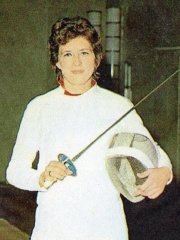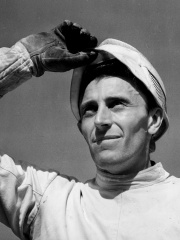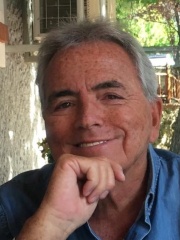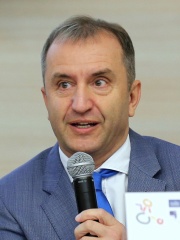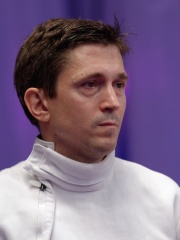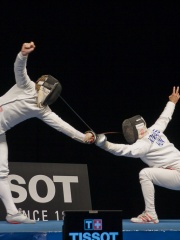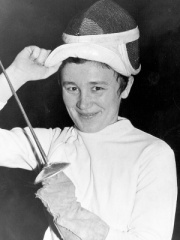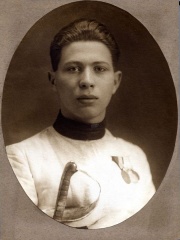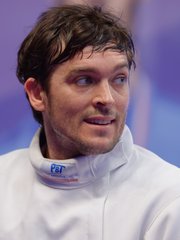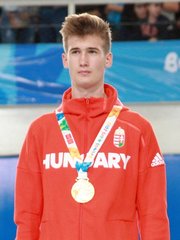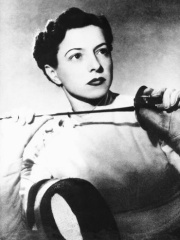
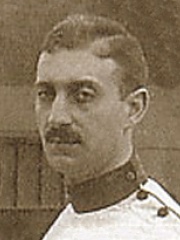
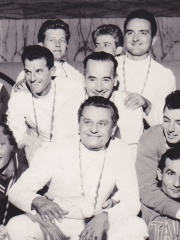
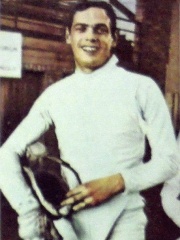
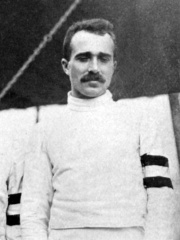
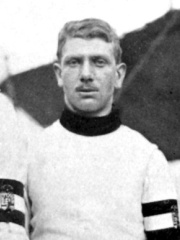

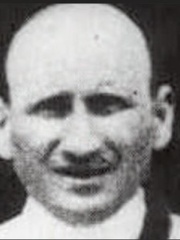
The Most Famous
FENCERS from Hungary
Top 10
The following people are considered by Pantheon to be the top 10 most legendary Hungarian Fencers of all time. This list of famous Hungarian Fencers is sorted by HPI (Historical Popularity Index), a metric that aggregates information on a biography's online popularity. Visit the rankings page to view the entire list of Hungarian Fencers.

1. Ilona Elek (1907 - 1988)
With an HPI of 62.46, Ilona Elek is the most famous Hungarian Fencer. Her biography has been translated into 29 different languages on wikipedia.
Ilona Elek, known also as Ilona Elek-Schacherer (née “Elek"; 17 May 1907 – 24 July 1988) was a Hungarian Olympic fencer. Elek won more international fencing titles than any other woman.

2. Lajos Werkner (1883 - 1943)
With an HPI of 59.81, Lajos Werkner is the 2nd most famous Hungarian Fencer. His biography has been translated into 21 different languages.
Lajos Werkner (23 October 1883 – 12 November 1943) was a Hungarian Olympic champion sabre fencer.

3. Pál Kovács (1912 - 1995)
With an HPI of 59.73, Pál Kovács is the 3rd most famous Hungarian Fencer. His biography has been translated into 26 different languages.
Pál Kovács (17 July 1912 – 8 July 1995) was a Hungarian athlete, who began as a hurdler, but eventually switched to fencing. By the time Kovács won his first fencing gold, in 1936, he had already been a member of the winning Hungarian team at the 1933 World Championships. The Hungarians won team sabre gold in five successive Olympics, lasting from 1936 until 1960. The same team won gold eight back-to-back world championships (including the two Olympics, which double as world championships in their respective years). Kovács also won individual gold in 1952, as well as individual bronze in 1948. In 1980, he became vice-president of the Fédération Internationale d'Escrime. He died in Budapest in July 1995.

4. Győző Kulcsár (1940 - 2018)
With an HPI of 59.59, Győző Kulcsár is the 4th most famous Hungarian Fencer. His biography has been translated into 29 different languages.
Győző Kulcsár (18 October 1940 – 19 September 2018) was a Hungarian fencer. He competed in the individual and team épée events at the 1964, 1968, 1972 and 1976 Olympics and won four gold (one individual and three team) and two individual bronze medals. He also won three world titles with the Hungarian team, in 1970, 1971 and 1978. After retiring from competitions Kulcsár worked as a fencing coach, in Hungary (c. 1980–1988 and after 2001) and Italy (c. 1988–2000). His trainees include Tímea Nagy, Emese Szász and his nephew Krisztián Kulcsár. He died on 19 September 2018 at the age of 77.
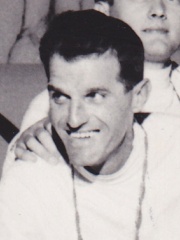
5. Rudolf Kárpáti (1920 - 1999)
With an HPI of 59.11, Rudolf Kárpáti is the 5th most famous Hungarian Fencer. His biography has been translated into 25 different languages.
Rudolf Kárpáti (17 July 1920 – 1 February 1999) was a fencer from Hungary, who won six gold medals in sabre at four Olympic Games (1948–1960). He also won seven gold, three silver and two bronze medals at the world championships. For his achievements he was named Hungarian Sportsman of the year in 1959 and 1960. Kárpáti graduated from the National Conservatory majoring in the history of music; he was also an accomplished violinist and the artistic director of the People’s Army Central Artistic Ensemble (1961–1986). Besides fencing and music, he was an employee at the Hungarian State Credit Bank and an officer with the Hungarian Army – he retired as Colonel, and later in 1990 was promoted to Major General. Kárpáti was a member of the Hungarian Fencing Federation from 1961 to 1991. After retiring from competitions, in 1977 he became president of the Budapest Fencing Federation and an administrator with the Fédération Internationale d'Escrime.

6. Péter Tóth (1882 - 1967)
With an HPI of 59.03, Péter Tóth is the 6th most famous Hungarian Fencer. His biography has been translated into 20 different languages.
Dr. Péter Tóth (12 July 1882 – 28 February 1967) was a Hungarian fencer who competed at the 1906 Intercalated Games and the 1908, 1912 and 1928 Olympics. He won team gold medals in sabre in 1908 and 1912, finishing fifth-sixth individually; he won an individual bronze medal in the sabre three hits event in 1906. In 1928, he placed fifth in the team foil. Domestically, Tóth won 17 Hungarian foil and sabre titles between 1907 and 1934 and competed until 1937. Tóth was a founding member of Fédération Internationale d'Escrime in 1913. He died in Budapest, aged 84, after being hit by a truck.

7. Oszkár Gerde (1883 - 1944)
With an HPI of 58.68, Oszkár Gerde is the 7th most famous Hungarian Fencer. Her biography has been translated into 20 different languages.
Oszkár Pál Gerde (8 July 1883 – 8 October 1944) was a Hungarian sabre fencer who won team gold medals at the 1908 and 1912 Olympics. After finishing his active career he judged international fencing competitions and worked as a lawyer. Being a Jew, he was deported from Hungary in 1944, and killed in the same year at the Mauthausen-Gusen Concentration Camp in Austria. In 1989 he was inducted into the International Jewish Sports Hall of Fame.

8. Dezső Földes (1880 - 1950)
With an HPI of 58.57, Dezső Földes is the 8th most famous Hungarian Fencer. His biography has been translated into 22 different languages.
Dezső Földes (born Dezső Grünfeld; 30 December 1880 in Miskolc, Kingdom of Hungary – 27 March 1950 in Cleveland, United States) was a Hungarian saber fencer.

9. János Garay (1889 - 1945)
With an HPI of 57.44, János Garay is the 9th most famous Hungarian Fencer. His biography has been translated into 20 different languages.
János Garay (23 February 1889 – 21 April 1945) was a Jewish Hungarian fencer, and one of the best sabre fencers in the world in the 1920s. Gaining international recognition in Olympic sabre competition, he distinguished himself winning a gold medal in 1928 in Amsterdam, and a silver and bronze medal in 1924 in Paris.

10. István Kausz (1932 - 2020)
With an HPI of 57.29, István Kausz is the 10th most famous Hungarian Fencer. His biography has been translated into 18 different languages.
István Kausz (18 August 1932 – 3 June 2020) was a Hungarian fencer. He won a gold medal in the team épée event at the 1964 Summer Olympics. Born in Budapest, Kausz competed for Budapest Vasas Sports Club before moving to Budapest Progress and then finally moving to OSC in 1957 until 1970 when he retired. Kausz started out as a pentathlete, he would later just concentrate on the Épée form of fencing. Kausz was part of the Hungarian team that won the épée team gold at the 1959 World Fencing Championships, which was held in his home city of Budapest, the following year he competed in the 1960 Summer Olympics. In the individual épée event, Kausz managed to get through three rounds before finishing last in his semi-final group, in the team épée, the team reached the semi-finals before losing to Great Britain and then lost to the Soviet Union team in the contest for the bronze medal. In between his Olympic appearances, Kausz won the individual gold medal at the 1962 World Fencing Championships. At the 1964 Summer Olympics, Kausz only managed to reach the second round in the individual épée, but in the team épée, with fellow countrymen, Győző Kulcsár, Zoltán Nemere, Tamás Gábor and Árpád Bárány, went all the way to the final and beat the Italian team to win the gold medal. During his sporting years Kausz also managed to earn a degree in medicine and would later become a doctor for the Hungarian swimming team, and was part of the Hungarian Olympic medical team for six summer Olympics.
People
Pantheon has 55 people classified as Hungarian fencers born between 1880 and 2002. Of these 55, 34 (61.82%) of them are still alive today. The most famous living Hungarian fencers include Péter Bakonyi, Ildikó Újlaky-Rejtő, and Tibor Pézsa. The most famous deceased Hungarian fencers include Ilona Elek, Lajos Werkner, and Pál Kovács. As of April 2024, 8 new Hungarian fencers have been added to Pantheon including Csaba Köves, Péter Abay, and Péter Somfai.
Living Hungarian Fencers
Go to all RankingsPéter Bakonyi
1938 - Present
HPI: 55.22
Ildikó Újlaky-Rejtő
1937 - Present
HPI: 54.37
Tibor Pézsa
1935 - Present
HPI: 53.37
Tamás Kovács
1943 - Present
HPI: 51.32
Sándor Erdős
1947 - Present
HPI: 50.67
György Nébald
1956 - Present
HPI: 49.28
Imre Bujdosó
1959 - Present
HPI: 49.28
Pál Szekeres
1964 - Present
HPI: 48.10
Péter Abay
1962 - Present
HPI: 47.50
Bence Szabó
1962 - Present
HPI: 46.38
Géza Imre
1974 - Present
HPI: 45.55
Iván Kovács
1970 - Present
HPI: 45.09
Deceased Hungarian Fencers
Go to all RankingsIlona Elek
1907 - 1988
HPI: 62.46
Lajos Werkner
1883 - 1943
HPI: 59.81
Pál Kovács
1912 - 1995
HPI: 59.73
Győző Kulcsár
1940 - 2018
HPI: 59.59
Rudolf Kárpáti
1920 - 1999
HPI: 59.11
Péter Tóth
1882 - 1967
HPI: 59.03
Oszkár Gerde
1883 - 1944
HPI: 58.68
Dezső Földes
1880 - 1950
HPI: 58.57
János Garay
1889 - 1945
HPI: 57.44
István Kausz
1932 - 2020
HPI: 57.29
Ildikó Schwarczenberger
1951 - 2015
HPI: 57.24
Attila Petschauer
1904 - 1943
HPI: 56.94
Newly Added Hungarian Fencers (2025)
Go to all RankingsCsaba Köves
1966 - 2025
HPI: 53.89
Péter Abay
1962 - Present
HPI: 47.50
Péter Somfai
1980 - Present
HPI: 35.52
Máté Tamás Koch
1999 - Present
HPI: 32.42
Tibor Andrásfi
1999 - Present
HPI: 32.33
Eszter Muhari
2002 - Present
HPI: 32.05
Dávid Nagy
1999 - Present
HPI: 31.69
Krisztián Rabb
2001 - Present
HPI: 30.35
Overlapping Lives
Which Fencers were alive at the same time? This visualization shows the lifespans of the 18 most globally memorable Fencers since 1700.


